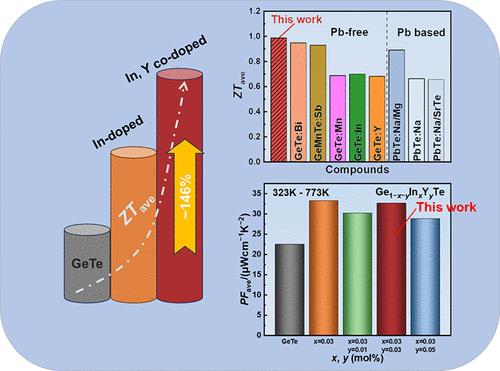当前位置:
X-MOL 学术
›
ACS Appl. Mater. Interfaces
›
论文详情
Our official English website, www.x-mol.net, welcomes your
feedback! (Note: you will need to create a separate account there.)
Synergetic Optimization via Indium and Rare Metal Yttrium Co-doping in GeTe Results in High Power Factor and Excellent Thermal Performance
ACS Applied Materials & Interfaces ( IF 8.3 ) Pub Date : 2024-11-18 , DOI: 10.1021/acsami.4c15281 Zhengtang Cai, Yu Fang, Chun Ma, Kaipeng Zheng, Kang Lei, Shanming Ke, Renkui Zheng, Han Li
ACS Applied Materials & Interfaces ( IF 8.3 ) Pub Date : 2024-11-18 , DOI: 10.1021/acsami.4c15281 Zhengtang Cai, Yu Fang, Chun Ma, Kaipeng Zheng, Kang Lei, Shanming Ke, Renkui Zheng, Han Li

|
Excess intrinsic Ge vacancies in GeTe materials lead to excessively high hole concentration and high thermal conductivity, producing poor thermoelectric performance. Here, synergistic control and optimization of the thermoelectric transport properties and microstructure of GeTe-based materials were achieved through co-doping with In and rare earth element Y, resulting in a significant enhancement of thermoelectric performance. The Ge0.94In0.03Y0.03Te sample reached a ZTmax of 1.84 at 773 K, representing an increase of around 91% compared to the GeTe matrix. The experimental results indicate that the doping of In optimizes the band structure by introducing resonant levels and increasing the degeneracy of the valence band. Y doping introduces in situ nanoscale secondary phases and lattice distortions due to defect generation, enhancing phonon scattering and significantly reducing the κlat. This work elaborates on how co-doping with In and Y achieves the optimization of the thermoelectric performance of GeTe-based materials. While the electrical transmission characteristics are improved, the thermal conductivity is significantly reduced. For the Ge0.94In0.03Y0.03Te sample, κlat decreased to ∼0.56 W m–1 K–1 at 573 K, resulting in a ZTave of ∼0.99 over the entire temperature range, representing over 140% improvement compared to undoped GeTe. This improvement is significantly higher compared with other works on GeTe and PbTe.
中文翻译:

通过 GeTe 中的铟和稀有金属钇共掺杂进行协同优化,从而获得高功率因数和出色的热性能
GeTe 材料中过多的本征 Ge 空位导致空穴浓度过高和热导率过高,热电性能不佳。在这里,通过与 In 和稀土元素 Y 的共掺杂,实现了对 GeTe 基材料的热电传输性能和微观结构的协同控制和优化,从而显着提高了热电性能。Ge0.94In0.03Y0.03Te 样品在 773 K 处达到 1.84的最大 ZT,与 GeTe 基体相比增加了约 91%。实验结果表明,In 的掺杂通过引入谐振能级和增加价带的简并性来优化能带结构。Y 掺杂引入了原位纳米级二次相和由于缺陷产生而导致的晶格畸变,增强了声子散射并显着降低了 κlat。这项工作详细阐述了 In 和 Y 的共掺杂如何实现 GeTe 基材料的热电性能优化。虽然电力传输特性得到改善,但导热性显著降低。对于0.03Y0.03Te 中 Ge0.94样品,在 573 K 时 κlat 降至 ∼0.56 W m–1 K–1,导致整个温度范围内的 ZTave 为 ∼0.99,与未掺杂的 GeTe 相比,性能提高了 140% 以上。与 GeTe 和 PbTe 的其他工作相比,这种改进明显更高。
更新日期:2024-11-18
中文翻译:

通过 GeTe 中的铟和稀有金属钇共掺杂进行协同优化,从而获得高功率因数和出色的热性能
GeTe 材料中过多的本征 Ge 空位导致空穴浓度过高和热导率过高,热电性能不佳。在这里,通过与 In 和稀土元素 Y 的共掺杂,实现了对 GeTe 基材料的热电传输性能和微观结构的协同控制和优化,从而显着提高了热电性能。Ge0.94In0.03Y0.03Te 样品在 773 K 处达到 1.84的最大 ZT,与 GeTe 基体相比增加了约 91%。实验结果表明,In 的掺杂通过引入谐振能级和增加价带的简并性来优化能带结构。Y 掺杂引入了原位纳米级二次相和由于缺陷产生而导致的晶格畸变,增强了声子散射并显着降低了 κlat。这项工作详细阐述了 In 和 Y 的共掺杂如何实现 GeTe 基材料的热电性能优化。虽然电力传输特性得到改善,但导热性显著降低。对于0.03Y0.03Te 中 Ge0.94样品,在 573 K 时 κlat 降至 ∼0.56 W m–1 K–1,导致整个温度范围内的 ZTave 为 ∼0.99,与未掺杂的 GeTe 相比,性能提高了 140% 以上。与 GeTe 和 PbTe 的其他工作相比,这种改进明显更高。


















































 京公网安备 11010802027423号
京公网安备 11010802027423号